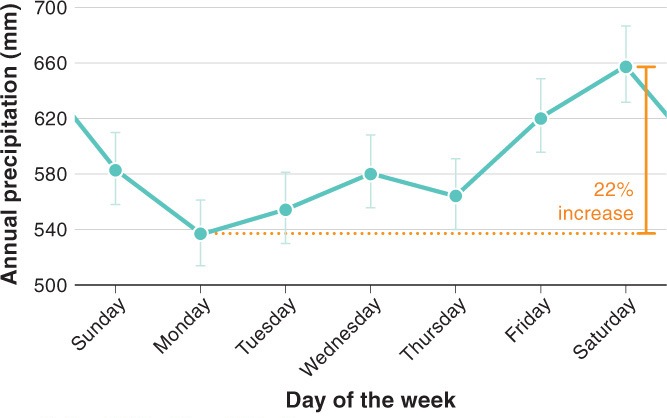KNOWLEDGE YOU CAN USE


Question 1.11
Q: What’s the most important outcome of scientific thinking? “Scientific thinking tells us when to change our minds about the natural world.” Let’s consider a question that might seem silly—
Question 1.12
Q: It often seems to rain more on weekends. Could it be true? Before you read on, write down your one-
Question 1.13
Q: Well, does it rain more on weekends? At first, it seems that the answer must be no. How could the weather even “know” what day it is? Weather, after all, existed long before humans, calendars, and Monday mornings.
Rather than relying on common sense, let’s think scientifically.
My hypothesis: It rains more on weekends.
Restated as a null hypothesis: The amount of rainfall does not differ across the days of the week.
A testable prediction: The amount of rainfall should not differ depending on what day of the week it is.
And now the data …
In a 1998 study published in the journal Nature, researchers used 17 years of data to analyze rainfall along the eastern coast of North America. Here’s what they found: there was 22% more rain on Saturdays than on Mondays! (And this difference was statistically significant.)

Question 1.14
Q: How can this be? The researchers also tracked the pollutants carbon monoxide and ozone, and found that both gradually increased from Monday through Friday. This pattern, they suggested, is probably related to accumulations from driving, which is greater during the week than on weekends. They suggested that the weekly pollution cycle causes increased cloud formation and rain on weekends (while the reduced pollution on Mondays leads to reduced rainfall). In other words, human activities are influencing the weather!
One good hypothesis deserves another. If their suggestion is true, we should expect the “Rainy Saturday/Dry Monday” phenomenon to occur only in the vicinity of human activities. As a test of this hypothesis, the researchers measured daily rainfall patterns over the oceans in the northern hemisphere, away from large human populations. Here they found that one-
Question 1.15
Q: The take-

33